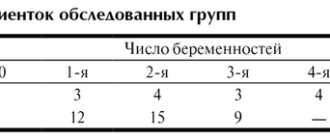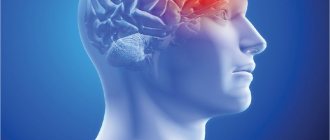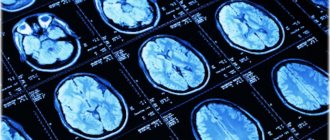Coma is a borderline state between life and death. The result of inhibition of nerve impulses in the cerebral cortex, subcortex, and underlying sections. Clinically manifested by lethargy or loss of consciousness, decreased/lack of response to external stimuli, and disappearance of reflexes. Let's look at why coma develops after a stroke, what its duration is, the chances of survival and a full recovery.
Mechanism of coma development
Damage to neurons is accompanied by changes in the metabolism of nervous tissue. Intracellular fluid exits into the intercellular space. As it accumulates, it compresses the capillaries, causing the nutrition of nerve cells to deteriorate even more and their work to be disrupted. A comatose state can develop very quickly (several seconds or minutes) or gradually (up to several hours, less often days). Most often, coma occurs after a massive or brainstem stroke caused by hemorrhage, less often by blockage of the cerebral arteries.
Causes
Post-stroke cerebral coma is a common complication of hemorrhagic and ischemic stroke of the brain. This condition occurs when a major brain accident disrupts the normal functioning of the central nervous activity.
The following conditions can trigger ischemic stroke:
- Atherosclerosis of cerebral vessels. When intravascular proliferation of an atherosclerotic plaque occurs, a blockage of the lumen of this vessel is observed, leading to disruption of the nutrition of a separate area of the brain;
- Hemodynamic disorders. With constant lability of blood pressure and organic disorders in the vessels of the brain, a violation of the nutrition of soft tissues occurs;
- Cardioembolic disorders. In this case, the blockage of blood vessels in the brain is caused by blood clots brought in from the heart valves or heart chambers. Conditions such as myocardial infarction and arrhythmia can provoke blood clot detachment.
The following factors contribute to the development of so-called coma and hemorrhagic stroke:
- Presence of vascular aneurysms;
- External damage to large vessels;
- Defect in the development of the blood vessel wall.
Hemorrhagic cerebral stroke is a more severe and life-threatening condition. This condition is associated with cerebral hemorrhage. Brain hemorrhage is difficult to deal with. Coma after a hemorrhagic stroke is more difficult to tolerate.
Severity
There are 5 degrees of coma after a stroke of varying severity:
- Precoma – moderate confusion, stupor. The victim looks drowsy, reacts inhibited to external stimuli, or, on the contrary, is overly active.
- 1st degree – severe deafness. The patient reacts very slowly to strong external stimuli, including pain. Can perform simple actions (rolling around in bed, drinking), respond with a meaningless set of words/individual sounds, muscle tone is weak.
- 2nd degree – loss of consciousness (stupor), basic reflexes are preserved (reaction of the pupils to light, closing of the eye when touching the cornea). When approaching the patient, there is no reaction, his rare movements are chaotic. Pain reflexes are suppressed. The nature of breathing changes: it becomes intermittent, shallow, and irregular. Possible involuntary urination and bowel movements. Trembling of individual muscles and twisting of limbs are observed.
- 3rd degree – loss of consciousness, absence of pain response, some basic reflexes. Involuntary urination, defecation. Muscle tone is reduced. The pulse is palpable poorly, breathing is irregular and weak, body temperature is reduced.
- 4th degree (extraordinary) – absence of any reflexes. Agonal breathing, palpitations, ends in death.
Why is an artificial coma needed?
An artificial state is called a coma, which is achieved by administering narcotic substances (most often barbiturates) or cooling the patient’s body to a temperature of 33 degrees. They cause cerebral vasoconstriction, slowing cerebral blood flow, and reducing blood volume. Medically induced coma during stroke is necessary for some patients to eliminate cerebral edema - the most severe complication, causing more than 50% of deaths.
This technique is rarely used due to the large number of complications and unexpected results.
Hemorrhagic stroke and its periods
Hemorrhagic stroke refers to sudden bleeding into the cranial cavity. Hemorrhagic strokes account for about 10% of acute cerebrovascular accidents
, the remaining
90% are ischemic strokes
.
This pathology most often occurs in people 45-70 years old
, but can develop even in a child and is often fatal. How long they live after hemorrhage and the prognosis are determined by the size of the affected area and the speed and quality of the treatment started.
Hemorrhage during a stroke can be either small-focal or extensive, depending on the caliber of the affected vessel. After a vessel ruptures, a hematoma occurs or hemorrhagic penetration of the brain tissue occurs. Pathology occurs according to the following periods:
- acute - the first day after the development of the disease;
- acute - 2 days - 21 days;
- subacute - from the beginning of the 4th week to 3 months;
- early recovery - 3 months - six months;
- late recovery - up to a year after the stroke;
- the period of long-term consequences is more than a year from the stroke.
Duration of coma
The duration of a coma can be very different: from several hours to several days or weeks. Some patients die without regaining consciousness. Rarely does a patient remain in a coma for several months, a year, or more. But the chances of recovery after such a long coma are extremely low.
A quick exit is more likely when:
- moderate area of necrosis;
- ischemic nature of stroke;
- partial preservation of reflexes;
- young age of the patient.
Prognosis, recovery after coma
Post-stroke coma is considered the most severe type of coma (1):
- only 3% of patients manage to recover and fully recover;
- 74% of comas after a stroke end in death;
- 7% of patients manage to regain consciousness, but they lose all higher functions (the ability to think, talk, perform conscious actions, carry out commands);
- 12% of patients remain deeply disabled;
- 4% of people recover, maintaining moderate impairment.
Factors influencing the forecast:
- Localization of the focus of necrosis. If a stroke affects the medulla oblongata, where the centers for controlling breathing and heartbeat are located, death occurs very quickly.
- Duration of coma: the longer it lasts, the less hope for a full recovery, the higher the risk of death.
- Depth of coma. In medicine, the Glasgow scale is used to assess it. During the examination, the doctor tests a person’s ability to open their eyes when exposed to various stimuli, speech, and motor reactions. For each attribute a certain point is awarded (table). The lower the score, the less favorable the outcome for the patient.
| Reaction | Ball |
| Eye opening when pressed | |
| There is | 2 |
| No | 1 |
| In response to the patient's question | |
| answers inappropriately | 3 |
| makes strange sounds | 2 |
| does not react | 1 |
| When a limb is pinched forcefully | |
| withdraws | 4 |
| bends | 3 |
| unbends | 2 |
| does not react | 1 |
Coma degree (based on total points):
- 6-7 – moderate;
- 4-5 – deep;
- 0-3 – brain death.
Recommendations for relatives of patients
A person emerging from a coma requires increased attention.
To avoid the recurrence of apoplexy, the following recommendations must be observed:
- inspire hope for recovery;
- create a favorable psychological climate and comfortable environment;
- motivate for daily exercise and praise for success;
- master manual massage skills.
Only love, care and attention can work miracles. Love and take care of yourself and your loved ones, and a favorable prognosis will not be long in coming.
- Nutrition for stroke and diabetes: what can a diabetic eat?
Treatment, patient care
The treatment regimen for comatose patients differs little from the management of other patients after a stroke. In the event of an ischemic stroke, the main task of the doctor is to restore the patency of the brain vessels and prevent recurrent thrombus formation. Both types of stroke require the use of diuretics that reduce brain swelling and intracranial pressure.
Patients are also prescribed medications to correct blood pressure levels and heart function. If a person cannot breathe on his own, he is connected to a ventilator.
Patients in a coma after a stroke require round-the-clock care. To prevent bedsores, patients are turned over every 2-3 hours, and pads and bolsters are placed under protruding parts of the body. Every day a person is washed, washed, diapers or urine bags are changed.
Comatose patients are fed through a feeding tube - a plastic tube that is inserted into the stomach through the nose. The patient's diet consists of various liquid dishes: pureed soups, vegetables, infant formula.
The study showed that patients who were given recordings of relatives' family stories recovered faster and better. While scrolling through the recording, memory and speech areas in their brains were activated (4).
Therefore, relatives are advised to talk with their loved ones. Be sure to introduce yourself first. Then tell the patient how your day went, remember some events that unite you. Be sure to express your love and tell him that you are looking forward to his recovery.
Prevention
The main preventive measure in this case is the prevention of extensive cerebral stroke. You need to remember 5 simple rules:
Blood pressure should be under control. If possible, purchase a tonometer for home use. This is especially true for older people. Semi-automatic or automatic devices are more suitable for them. Blood pressure should be measured three times a day. Record the results.
Doctors recommend reducing the amount of cholesterol. To do this, you need to change your diet and add exercise.
- Why does coma occur during a stroke and are there any chances?
As prescribed by your doctor, you can take medications to prevent the formation of blood clots. They are especially needed for those who have undergone surgery or suffer from vascular pathologies, such as varicose veins.
Also, timely consultation with a doctor will protect you from stroke and, as a result, from coma. None of the alarming symptoms should be ignored.
Coming out of a coma
The process of coming out is not like waking up. The first symptom is that the patient opens his eyes and keeps them open for some time. So far he does not respond to voice or touch. The patient's gaze is usually not focused, he looks somewhere into the distance. Chaotic movements of arms and legs are possible.
As the person improves, he begins to “wake up” from pain (for example, a pinch or touch). Movements become more purposeful. For example, the patient may try to pull out the catheter. Unfortunately, sometimes this is the maximum result that can be achieved.
Stable improvement is said to occur if a person begins to respond to being called by name and becomes able to follow simple instructions (shake a hand, move a leg). If everything goes well, the patient's condition will continue to improve. He can begin to recognize those around him, carry on a conversation, fulfill requests, and become interested in what is happening. Further recovery depends on the severity of brain damage due to stroke or coma.











